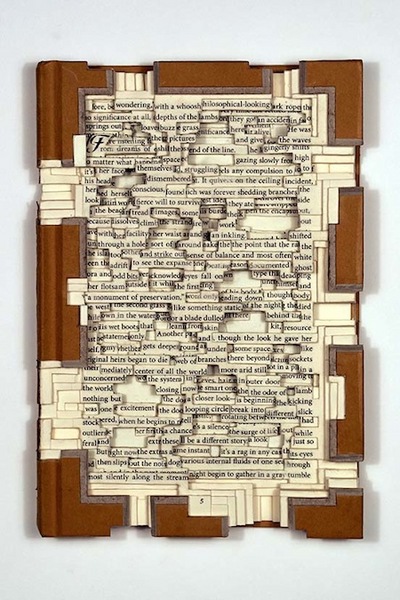Altered Books
Curatorial essay by Catherine E. Doubler
Transforming or altering a book is a sculptural act. The pre-altered book is raw material, similar to clay or marble, to the artist who transforms books. The book artist who alters books makes use of subtractive and additive techniques. Carving, sanding away, cutting, pasting, and painting over, the book artist uncovers objects hidden within the book structure, perhaps violating the text, but through that violation calling attention to the ephemerality of books.
Pamela Paulsrud's Touchstones is a series of books that Paulsrud sanded down into miniature books that look like the kind of smooth rocks ideal for stone-skipping. The copy in MARBL's possession is sculpted from a book with a moss-green cover, and once one begins to flip through the book, it becomes increasingly clear that the book once was a catalog for an art museum, with its design and typeface indicating a publication date in the 1960s or 1970s. Books such as these function in the ways that books "should"—to reify, represent, and distribute authoritative information or narratives. However, Paulsrud's transformation of this text calls this encyclopedic function into question. According to a statement on her website, she chose the artist’s book form for its evocation and use of “nonverbal narratives,” and Touchstones deploys the irony of using a medium of verbal communication to convey a nonverbal message. With this book, Paulsrud “convey[s] a language in the absence of text that speaks of the complex interaction of nature and humanity.” Using a manmade object—the book—like raw, unpolished material for sculpture, Paulsrud transforms the book into a natural object.
Atlanta-based book artist Brian Dettmer’s unique work We Kill One, which MARBL acquired in the fall of 2012, was altered from a copy of novelist T.C. Boyle’s When the Killing’s Done. Using scalpels, tweezers, and other such tools, Dettmer often likens his bookmaking process to dissection. He also notes the exegetical dimensions of his practice: “Working through the book is like reading, one page at a time, deciding what to remember, what to highlight and what to discard. The finished piece is the result of my intention, the book's insight, exposed meanings and random fragments open to new meanings and new interpretations.” In this sense, Dettmer turns the reading process on its head; the act of reading can no longer be seen as passive, but instead requires the creative initiative and struggle of the reader. Moreover, if one takes Dettmer’s other metaphor—that of reading as surgery—to its logical conclusions, then the book is positioned as an organism requiring medical intervention, a form in need of revitalization and reconstruction.
Not all altered books are created with subtractive sculptural techniques in mind. Many artists, such as Mar Goman, choose to transform preexisting books by adding materials to them. Poems of Dylan Thomas is a unique book to which Goman appended a variety of found objects: matches, bits of fabric, old photographs, rusty razors. The rationale for adding these objects to the book comes across on one of the first pages, onto which Goman has glued a page of Braille writing. This addition resituates the reader's expectations: Goman's book is about reapproaching Dylan's poems through tactile acts of reading. Goman also sews into the book, glues pages together, and paints over the poems in order to highlight themes and phrases in the volume that strike her. For instance, Goman analyzes the line "What is the metre of the dictionary?" (from "Altarwise by Owl-Light") by gluing pages of the dictionary into the book. Goman explores Thomas's question by making dictionary entries become a part of a book of poetry. Adding material to the book is the method Goman adopts to interpret Dylan Thomas's poems.
Artists who alter books make us take a second look at the codex form. By transforming a preexisting book, the artist states that the book form itself is in need of a transformation. And, by implication, the artist challenges the didactic and narrative function of books. Altering books, then, becomes a form of nonverbal social and intellectual critique.
Sources:
Johanna Drucker, A Century of Artists’ Books.
Vamp and Tramp website for Brian Dettmer: http://www.vampandtramp.com/finepress/d/brian-dettmer.html
Pamela Paulsrud’s website: http://pamelapaulsrud.com/artwork/197502_Touchstones.html


